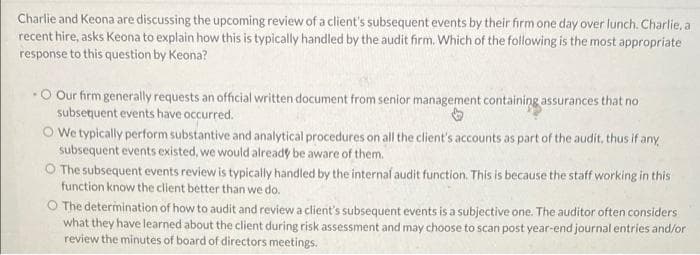O The determination of how to audit and review a client's subsequent events is a subjective one. The auditor often considers
O The determination of how to audit and review a client's subsequent events is a subjective one. The auditor often considers
Auditing: A Risk Based-Approach to Conducting a Quality Audit
10th Edition
ISBN:9781305080577
Author:Karla M Johnstone, Audrey A. Gramling, Larry E. Rittenberg
Publisher:Karla M Johnstone, Audrey A. Gramling, Larry E. Rittenberg
Chapter5: Professional Auditing Standards And The Audit Opinion Formulation Process
Section: Chapter Questions
Problem 40MCQ
Related questions
Question
1
what is the correct answer choice?

Transcribed Image Text:Charlie and Keona are discussing the upcoming review of a client's subsequent events by their firm one day over lunch. Charlie, a
recent hire, asks Keona to explain how this is typically handled by the audit firm. Which of the following is the most appropriate
response to this question by Keona?
O Our firm generally requests an official written document from senior management containing assurances that no
subsetuent events have occurred.
O We typically perform substantive and analytical procedures on all the client's accounts as part of the audit, thus if any
subsequent events existed, we would already be aware of them.
O The subsequent events review is typically handled by the internal audit function. This is because the staff working in this
function know the client better than we do.
O The determination of how to audit and review a client's subsequent events is a subjective one. The auditor often considers
what they have learned about the client during risk assessment and may choose to scan post year-end journal entries and/or
review the minutes of board of directors meetings.
Expert Solution
This question has been solved!
Explore an expertly crafted, step-by-step solution for a thorough understanding of key concepts.
This is a popular solution!
Trending now
This is a popular solution!
Step by step
Solved in 2 steps

Knowledge Booster
Learn more about
Need a deep-dive on the concept behind this application? Look no further. Learn more about this topic, accounting and related others by exploring similar questions and additional content below.Recommended textbooks for you

Auditing: A Risk Based-Approach to Conducting a Q…
Accounting
ISBN:
9781305080577
Author:
Karla M Johnstone, Audrey A. Gramling, Larry E. Rittenberg
Publisher:
South-Western College Pub

Auditing: A Risk Based-Approach (MindTap Course L…
Accounting
ISBN:
9781337619455
Author:
Karla M Johnstone, Audrey A. Gramling, Larry E. Rittenberg
Publisher:
Cengage Learning

Auditing: A Risk Based-Approach to Conducting a Q…
Accounting
ISBN:
9781305080577
Author:
Karla M Johnstone, Audrey A. Gramling, Larry E. Rittenberg
Publisher:
South-Western College Pub

Auditing: A Risk Based-Approach (MindTap Course L…
Accounting
ISBN:
9781337619455
Author:
Karla M Johnstone, Audrey A. Gramling, Larry E. Rittenberg
Publisher:
Cengage Learning